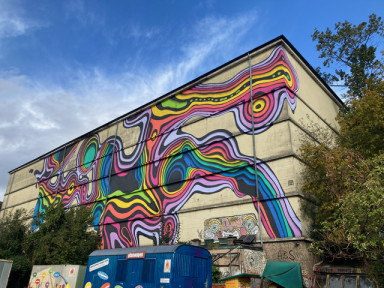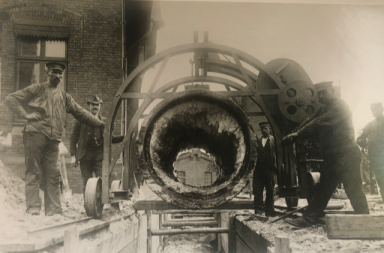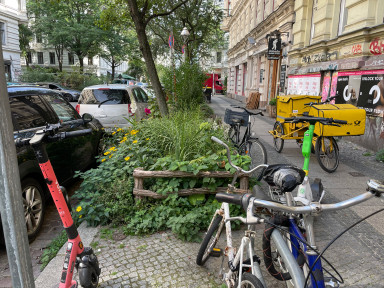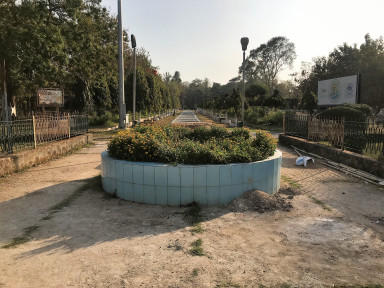Greening the bunkers
Implementing future visions in places from the past: A sociology of space perspective on two bunker conversion projects in Hamburg
This research focuses on the transformation processes of two high-rise bunkers in Hamburg into green spaces. Bunkers are places where the past and the materiality of cities, as well as heavy historical legacies, become particularly clear. A future orientation also becomes evident in that the greening projects are intended to contribute to climate change mitigation goals as well as to provide everyday sustainability and cultural experiences for the neighbourhood. Examining the tensions between past and future, between grey and green, and between historical concrete and flowering raised beds promises deeper insights into understanding the dynamics of meanings of the built environment.
- bunkers
- urban green spaces
- future visions
- heritage
- historical built environment
- materialities
- temporalities
- civil society
- transformation practices
Context
The dissertation builds upon recent social science research on the so-called do-it-yourself movement and the concept of do-it-yourself (DIY) urbanism.1 However, this research does not focus on the practices of do-it-yourself per se but instead draws from the conceptual sensibility of the notions of do-it-yourself urbanism and prefigurative movements2 to investigate a specific empirical phenomenon: the transformation of former war bunkers in Hamburg into urban green spaces. Specifically, the emphasis of the study is on civil society agencies participating in these transformative processes. Indeed, the two cases chosen for the present project both involve civil society initiatives contributing in different ways to the transformation process.
Aims
In the context of the particular situation of greening former war bunkers and the role of civil society within this situation, the research specifically investigates the articulation of material and temporal tensions unfolding throughout the transformation processes. On the one hand, there is the tension between a symbolic materiality inherited from the past and future-oriented conversions. On the other hand, the civil society initiatives that settled in the bunkers appear to engage with DIY, material, and spatial practices but in fairly divergent strategies. Hence, we could ask how civil society initiatives can contribute to a conversion that requires specific sets of expertise to be transformed. Or to put it more directly: How far can do-it-yourself be used to transform the bunkers?
When implementing sustainability-oriented spaces (rooftop gardens, educational raised beds, cultural and neighbourhood activities, etc.), the greening projects juggle with several layers of meaning in these bunkers inherited from the past. Embedded in the concrete of the bunker, heavy historical stories mingle with the lightness, spontaneity, malleability, and instability of the vegetal elements, the participants, the do-it-yourself practices, etc. Exploring these combinations can reveal insights and pathways for the maintenance of historical urban areas while addressing sustainability issues of cities in the 21st century. Thus, one main research question leads the project: How do greening projects in former war bunkers handle the coexistence of historical legacies and future visions?
Research design
Situated at the intersection of the fields of sustainability research and sociology of space, the research adopts a relational perspective considering space as a socio-physical research object.3 In order to investigate the transformation of the bunkers, a qualitative, explorative approach has been chosen to describe how actors from the chosen cases deal with the materiality and the temporality of the bunker. The analysis concentrates on the perspectives of civil society actors and their relations to the bunkers as well as to other involved actors. A hybrid data corpus constituted of go-along interviews, focused ethnography, discourse material, and visual data delivers insights about the moment of transformation. The analysis of these data types delivers elements for understanding how the investigated initiatives handle the historicity of the bunker while seeking to open up ‘spaces for future’. Situational analysis is used for analysing the data4: This analytic approach allows, through successive mappings of a situation of inquiry, a comprehensive overview of the multiple agencies and elements involved, as well as their interrelations. Therefore, the complexity of processes such as the transformation of historical sites can be accounted for, while at the same time, a specific search for the role played by civil society actors within that situation is enabled.
Supervisors:
- Prof. Dr. Katharina Manderscheid
- Prof. Dr. Anita Engels




